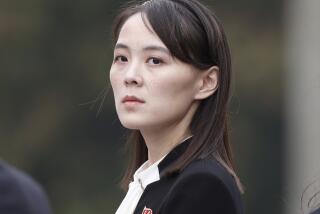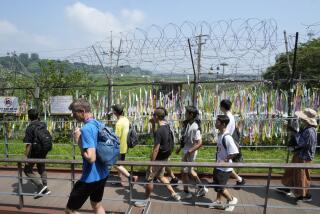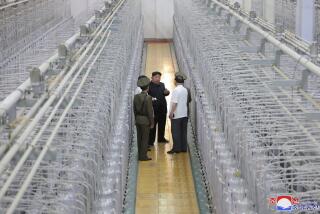From the archives: âBeloved Leaderâ Omnipresent
PYONGYANG, North Korea -- On a hill overlooking Pyongyang, 110 bronze busts of deceased soldiers and loyal friends of President Kim Il Sung stand in glory at the Revolutionary Martyrsâ Cemetery.
Most of them died in the 1930s and 1940s. Some died without ever having a picture taken, but the face of each is etched in detail. Creating likenesses of the fallen heroes presented a challenge, but it is said that the problem was solved by President Kim himself.
âThe sculptors asked the respected and beloved leader, and he explained in detail,â said Kim Jun Ho, a guide who accompanied visitors to the cemetery. âHe remembered their faces. They were his soldiers. So many years had passed--I think 50--but he remembered their faces.â
To hear North Koreans tell it, President Kim can do almost anything. Many stories are absurd, but there is no doubt that Kim holds so much power that his fate and that of his nation are inextricably linked.
The innumerable stories about Kim are among the bases of his power. They are part of the ideological glue that holds North Korea together.
Koreaâs liberation from Japanese rule, in 1945, is attributed almost entirely to Kimâs leadership, with a small assist from the Soviet army. It is as if the U.S. war effort and the atomic bombing of Hiroshima and Nagasaki had nothing to do with Japanâs defeat.
The North Korean occupation of Seoul just three days after the Korean War began in 1950 is attributed to a brilliant âcounterattackâ under Kimâs leadership. North Korea insists to this day that the south, instigated by the United States, started the war.
The end of the war, in stalemate in 1953, is portrayed as a glorious victory against U.S. imperialism. The idea that the north started the war in an attempt to reunify Korea under Kimâs control--accepted in the West as historical fact--is described as a vicious fabrication.
Virtually every accomplishment of North Korea is attributed to Kimâs brilliance. Occasional credit is given to his son and designated successor, the âDear Leaderâ Kim Jong Il. Generally there is no need to blame anyone for failure; there are no failures, no shortcomings.
âI think you have read George Orwellâs â1984,â â a European diplomat said in an interview in Beijing. âThere is a good saying: âThe one who is ruling the present also rules the past, and at the same time controls the future.â I think it relates to Kim Il Sung too.
âEverything is based on Kim Il Sung--such silly things, you cannot believe them. The whole history of the DPRK (the Democratic Peopleâs Republic of Korea) is based on Kim Il Sung. If there is any divergence, it should be destroyed.â
Future Hold Tenuous
While the 77-year-old Kim can decree what should be said about the past, his hold on the future is more tenuous. Especially questionable is his ability to hand over supreme power to his son.
âAbout the succession, I think itâs very difficult to say,â another European diplomat said, also in a Beijing interview. âKim Il Sung seems to be in good health, so whatever happens probably will not happen soon. This lump on his head (a baseball-sized protrusion at the back and on the right side) is not a big problem. Itâs not cancerous, because itâs been there a long time. . . . Thereâs really nothing available to be able to say anything.â
No one knows whether Kim Jong Il, 47, will someday be able to consolidate power, and opinions vary as to what kind of a leader he might prove to be.
Some who have met Kim Jong Il say he appears to be competent and that he might bring beneficial changes to his country. Others say he seems strangely detached from reality, even with visitors.
âItâs a pretty opaque situation,â a Western diplomat said in Beijing. âThereâs an impression that there is a group in the leadership that is more interested in opening to the outside. Whether that group is related to the âDear Leaderâ is a subject of debate.â
Linked to Terrorism
Some outsiders express hope for the possibility of change under a regime headed by Kim Jong Il, but there is also concern, prompted by charges linking the younger Kim to terrorism.
Last year, a North Korean woman, Kim Hyon Hui, confessed in Seoul, the South Korean capital, that she and a companion had placed a bomb on Flight 858 of Korean Air, the South Korean airline, before the plane disappeared over the ocean near Burma on Nov. 29, 1987, taking the lives of all 115 people on board. The young woman, who had been arrested in Bahrain after an unsuccessful suicide attempt and then extradited to South Korea, said she was told that her orders had come from Kim Jong Il.
People who question Kim Jong Ilâs ability point out that although he holds high positions in North Koreaâs ruling Communist party, officially the Korean Workersâ Party, he has never been given a significant government post, a step that might help him establish credibility as a successor.
But others point out that President Kim has never allowed anyone to accumulate sufficient power to emerge as a potential rival and that it is quite logical for this taboo to apply to his son.
âThis problem, in socialist countries, is not resolved--how to hand over power,â one of the diplomats in Beijing said. âIt is not institutionalized. . . . Anything can happen after Kim Il Sung.â
Great Changes Unlikely
Most experts consider it unlikely that significant change will come to North Korea while the elder Kim is alive. Over the last few years, however, there have been signs that Kim might be willing to modify his policy of rigid isolation from all but his Communist patrons in Moscow and Beijing.
Last Sept. 8, Kim gave a speech in which he declared that North Korea âshould develop good-neighborly, friendly relations with those capitalist countries that respect the sovereignty of our country.â
Early this month, Pyongyang welcomed about 20,000 delegates and visitors to the 13th World Festival of Youth and Students, a leftist political, sports and cultural gathering.
The festival glorified Kim in many ways. One of the most spectacular was the use of highly disciplined high school students organized in stadium sections to flash colored cards on cue, creating art displays with rural and urban scenes, and political messages or images of the âgreat leader.â Training for these displays is considered ideological education in collectivist action.
The festival also served Kimâs political purposes in that delegates readily endorsed North Korean demands that the United States pull its troops out of South Korea.
But the gathering also constituted the widest opening of Pyongyangâs door to the outside world since the end of World War II, with long-term implications that could be significant but are not entirely clear.
New Hotels Completed
In another possible sign of greater openness, several first-class hotels have been completed in Pyongyang in recent years. Structural work has been finished on the 105-story Ryugyong Hotel, the tallest hotel in Asia, but much additional work is needed before it can begin receiving guests.
In a normal society, an abundance of new international-standard hotel rooms would be proof of plans for a rapid expansion of tourism. But North Korea is not a normal society, and diplomatic experts tend to believe that the hotels do not signify any impending major opening to the world.
âIt has happened many times in socialist countries that they have built certain things for political prestige without any rational considerations,â one of the European diplomats in Beijing said. âIn North Korea there are many unnormal things. So this hotel (the Ryugyong) could even be empty. It is the tallest hotel in Asia. So some kind of prestigious goal--they have gained it.
âBut is Pyongyang a place where tourists really want to go? I donât think it is evidence that they might open, or that they are waiting for tourists to come to North Korea.â
Still, this diplomat said, North Korea faces major economic and political pressures that conceivably could force changes even during Kim Il Sungâs lifetime. The most important of these is that North Koreaâs key allies, the Soviet Union and China, have been gradually improving their ties with capitalist South Korea.
Various Ties Cited
Seoul has long had close ties to Washington and Tokyo, this diplomat pointed out, and now it is improving its relations with Moscow and Beijing.
Under Kimâs leadership, North Korea has placed great rhetorical emphasis on the reunification of north and south and has portrayed Pyongyang as the legitimate capital of the entire Korean nation. For Seoul to continue to pull ahead as a more important capital, both economically and politically, presents a fundamental challenge to the psychological underpinnings of Kimâs rule.
âIt could be a turning point if the Soviet Union and later China were to establish diplomatic relations with the south,â the diplomat added. âIf these four countries (the United States, Japan, the Soviet Union and China) all have diplomatic relations with the south, and the north has diplomatic relations with only two--and besides this, it is economically much weaker than the south--then even during the lifetime of Kim Il Sung it could force North Korea to make a certain opening.â
Late last year, U.S. and North Korean diplomats began a series of meetings in Beijing aimed at exploring possibilities for improved relations. Early this year, there also seemed to be progress in bilateral talks between Seoul and Pyongyang.
But the north-south talks have bogged down in mutual recriminations, touched off in part by a dramatic visit to Pyongyang in March by the South Korean dissident Moon Ik Hwan, and his arrest upon returning to the south.
Contrary Demands
The United States, which has maintained troops in South Korea since the Korean War, has made it clear that improved relations between Washington and Pyongyang depend on progress in the north-south talks. North Korea, for its part, is demanding an end to U.S.-South Korean military exercises. The last U.S.-North Korean meeting in Beijing was on May 15, with no progress reported.
The process of seeking ways to improve U.S.-North Korean relations has entered âa rough period,â a Western diplomat said in Beijing. âNo world youth festival is going to change that. Itâs kind of stalled.â
North Korea continues to emphasize a proposal that the northern and southern halves of the peninsula should be reunited under a loose confederation, taking a single seat in the United Nations but maintaining autonomous governments in each half of the country. As part of this process, under the northâs proposal, the 43,000 U.S. troops stationed in South Korea would be withdrawn.
In the south, authorities and opposition politicians do not rule out an eventual solution along these general lines, but they generally insist that there must be gradual confidence-building steps that would include expanded exchanges between the two sides. The north treats such proposals as delaying tactics and evidence of opposition to reunification.
Direct Dialogue Favored
âDirect dialogue between the north and the south would be very good after the U.S. Army gets out,â said Lt. Col. Kang Ho Sop, who spoke with visitors recently at a military post in the demilitarized zone near the border village of Panmunjom. âIf direct dialogue between the north and the south is for the reunification of the Fatherland, we welcome it. But if not, we oppose it.â
The north is firmly opposed, Kang said, to any proposal that would perpetuate the division of Korea, such as separate U.N. seats for North Korea and South Korea, which presently have only observer status at the United Nations.
âWe want one Korea,â Kang said. âWe donât want two Koreas. Before the divided country is reunited, we can never join the United Nations.â
The Koreans--north and south--are an intensely nationalistic people, and Kim has sought to link this patriotism to his rule.
The obstacles blocking the path toward reunification are immense, and not the least of them is the rigidity of Kimâs regime. But the idea of eventual reunification is taken seriously by politicians and ordinary citizens on both sides.
The martyrsâ cemetery overlooking Pyongyang also reflects deep emotions that Kim has sought to harness. The faces of some soldiers may, in truth, be drawn from imagination rather than Kimâs memory. But Japanese imperial control of Korea was indeed harsh, and there were freedom fighters who battled the occupation.
Busts of Mother, Son
One of them, according to an inscription at the cemetery, was Ma Dong Hi, who died in 1938 at the age of 25. Bronze busts of Ma and his mother, Jang Gil Bu, who lived to be 89, stand side by side.
The story told of Jang and her son, whether truth or myth, touches a chord in the hearts of many North Koreans. It is the type of story on which Kimâs rule is built.
âHe was an underground (anti-Japanese) activist,â the guide said of Ma. âHe was arrested and tortured severely. So he cut his tongue, so as not to reveal secrets.â
All of Jangâs sons and daughters, her sisters, sisters-in-law and husband, were killed in the anti-Japanese struggle, the guide added.
After the Japanese defeat, he said, the ârespected and beloved leaderâ Kim made sure that Jang was honored. She was later given the title âCommunist Mother.â
âShe dedicated everything to the country, the party and the revolution,â the guard said.
More to Read
Sign up for Essential California
The most important California stories and recommendations in your inbox every morning.
You may occasionally receive promotional content from the Los Angeles Times.










